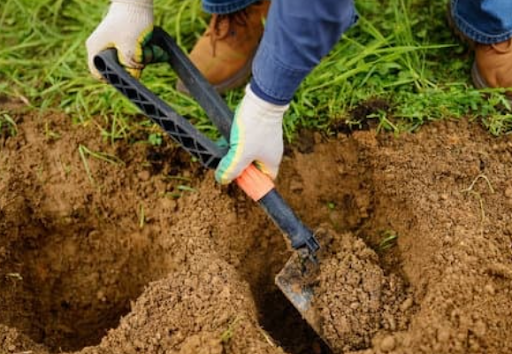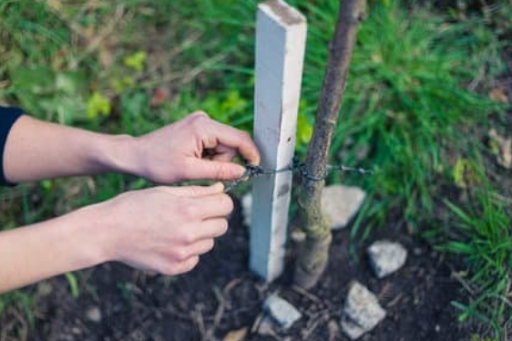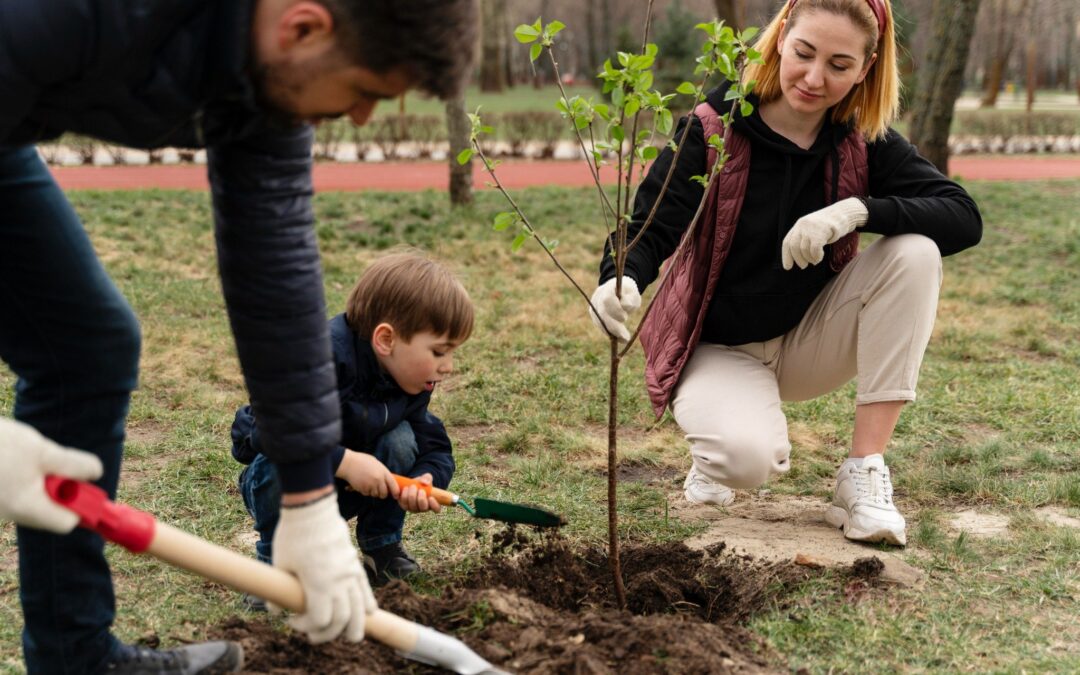Planting trees and flower beds in your yard is one of the best ways to boost your home’s attractiveness, create a relaxing outdoor space, and improve your home’s value. In Northeast Ohio, where the seasons are distinct and the soil can vary, planting the right way is essential. Mistakes made during planting can lead to root damage, poor growth, or early plant failure.
In this article, we’ll share the top seven dos and don’ts of tree and bed planting, with friendly, easy-to-follow advice that every homeowner can use. You’ll also learn how to plant around a tree the right way, what flowers grow well under trees, and how to keep your new landscape healthy for years to come.
1. Do Choose the Right Tree or Flower for the Space
- Do: Choose plants and trees that match your location’s sunlight, soil, and moisture conditions. Native plants are especially great choices in Northeast Ohio. They require less watering, are more resistant to local pests and diseases, and adapt better to our unpredictable seasons.
- Don’t: select a tree or flower just because it looks nice at the garden center. Ask yourself, will it get too big? Does it need more sun or water than I can provide? Always check the plant tag or ask a local plant nursery expert. Trees that outgrow their space can damage sidewalks, foundations, or nearby plants.
Pro Tip: Wondering what flowers to plant under trees? Try low-maintenance, shade-tolerant options like coral bells, astilbe, hostas, or bleeding hearts. They’re perfect for adding color without harming the tree’s root system.
2. Do Plant at the Right Time of Year
- Do: Plant in early spring (March to May) or early fall (late August to October). These seasons give roots a chance to grow before facing the stress of summer heat or winter frost.
- Don’t: Plant during extremely hot or dry months. It may seem like a good time to get outside, but your new plants are more likely to dry out or fail to establish in summer.
Seasonal planting gives trees and shrubs the best start possible, helping them develop strong root systems and better withstand Ohio’s chilly winters.
Bonus: Fall is a great time to plant perennials and trees because the soil is still warm, but the air is cooler, ideal conditions for root growth.
3. Do Dig the Hole the Right Way

- Do: Dig a wide hole, 2 to 3 times the width of the root ball, and only as deep as the root ball itself. The roots of trees and shrubs grow outward, not downward, so giving them room to spread helps with water absorption and stability.
- Don’t: Dig the hole too deep or too narrow. A deep hole can cause the tree to settle too low, leading to trunk rot. A narrow hole limits root growth and may lead to girdling roots that strangle the plant later.
When backfilling, use the same soil you dug out instead of adding bagged compost or garden soil. This helps the plant adjust to its natural surroundings.
Helpful Tip: After planting, gently press the soil down and water thoroughly to eliminate air pockets that could dry out the roots.
4. Do Remove Tags, Pots, and Wrappings
- Do: Remove all plastic pots, wires, tags, burlap, or other packaging materials before planting. These items can hinder root growth or constrict the trunk if left behind.
- Don’t: Assume that materials labeled as “biodegradable” can be left in the hole. Burlap and wire baskets, even if natural, take time to break down and may cause root girdling or poor establishment.
If you’re planting a container tree or shrub, gently loosen the roots with your fingers before planting. This encourages them to spread into the surrounding soil instead of staying in the shape of the pot.
Pro Tip: If you find circling roots on potted plants, cut or gently separate them. Circling roots can eventually strangle the plant if not addressed.
5. Do Water and Mulch the Right Way
- Dos
- Water deeply and consistently, especially during the first two years after planting. Deep watering encourages roots to grow deeper, making your plants stronger and more drought-resistant.
- Apply 2 to 3 inches of mulch around the base of your tree or bed. Mulch helps keep moisture in the soil, keeps weeds down, and protects against temperature swings.
- Don’ts
- Overwater or underwater. Shallow, frequent watering encourages weak root systems. Use a hose or slow-drip irrigation to water thoroughly once or twice a week, depending on rainfall.
- Pile mulch against the tree trunk. This is called a “mulch volcano,” and it can lead to bark rot and insect infestations. Keep mulch pulled back 2 to 3 inches from the base of the trunk.
Tip for planting beds under trees: Use mulch to reduce competition for water between tree roots and flowers. Apply a thin layer, no more than 3 inches, so roots can breathe.
6. Do Stake Trees Only If Needed

- Do: Stake a newly planted tree only if it’s in a windy spot or has a thin, weak trunk. Use flexible ties and soft materials, and allow some movement so the trunk strengthens naturally.
- Don’t: Leave stakes in place for more than one growing season. Over time, ties can cut into the bark, and a staked tree may not develop the strong trunk it needs to survive on its own.
Quick Check: After a year, remove the stakes and test the tree by gently wiggling the trunk. If it stands on its own, you’re good to go!
7. Do Maintain and Monitor
- Dos
- Check your tree or flower bed regularly for pests, signs of stress, or diseases. Catching issues early gives you time to treat them before they spread or cause permanent damage.
- Prune only dead or broken branches during the first year. After year one, light pruning can help shape the tree and remove crossing or weak limbs.
- Don’ts:
- Ignore yellowing leaves, slow growth, or wilting. These signs could mean your plant isn’t getting enough water, has compacted soil, or is dealing with an underground root issue.
- Prune too much or too soon. Over-pruning stresses the plant and may cause poor growth. Avoid fertilizing too early unless a soil test shows it’s needed.
Need to know: Want to know how to plant around a tree without harming it? Avoid cutting large roots, plant shallow-rooted flowers, and don’t dig too deep.
Bonus: Tips for Planting Beds Under Trees
Planting beds under trees is a beautiful way to add color and interest to your landscape, but it comes with special challenges. Tree roots can compete with flowers for water and nutrients, and too much soil or mulch around the trunk can harm the tree.
Do:
- Choose shade-loving flowers like lamium, brunnera, or epimedium.
- Plant between large surface roots instead of cutting into them.
- Add a thin layer of compost to improve soil health without raising the level too much.
Don’t:
- Build a raised bed around the tree trunk. This can smother roots and shorten the tree’s life.
- Use plants that need full sun or heavy fertilization; they won’t thrive in shady, root-filled spots.
- Forget to water. Even drought-tolerant flowers may need a little extra help, especially in dry seasons.
Planting under trees can be easy, as long as you work with nature, not against it.
Why Northeast Ohio Homeowners Trust Unique Landscaping
At Unique Landscaping, we know that every yard is different. That’s why we take the time to understand your soil, space, and vision before we plant. From Avon Lake to North Royalton and Strongsville to Westlake, we’ve helped hundreds of homeowners across Northeast Ohio transform their landscapes.
With every project, you get:
- A free consultation to plan the best layout for your space
- Our Unique Advantage Warranty™ for peace of mind
- A custom maintenance guide to help your new plants thrive long after planting
Whether you’re looking to learn how to plant around a tree or need help designing flower beds under trees, we’re here to support you every step of the way.
Ready to Start Planting?
Let’s grow something beautiful together. Unique Landscaping is your local expert in tree and bed planting for Northeast Ohio homeowners. Contact us today to schedule your free consultation and get expert help on how to plant the right way, the first time.
Call us or contact us online to get started. Serving Aurora, Berea, Lakewood, Brunswick, and other communities throughout Northeast Ohio.

